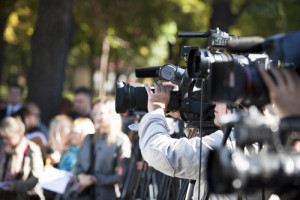Nebraska Legislature runs its own news service

By Deena Winter | Nebraska Watchdog
LINCOLN, Neb. — If you go to a hearing on a high-profile bill at the Nebraska Legislature, you might see a TV reporter here, a newspaper reporter there and a reporter who’s being paid by the Legislature itself.
GOVERNMENT REPORTERS: In addition to the dozen reporters covering the Nebraska Legislature, a handful of legislative employees also run their own news service about what goes on in the capitol.
In addition to the gaggle of TV, radio, online and newspaper reporters that regularly cover the Legislature, a handful of lesser-known reporters write about the Legislature while also working for it.
The Unicameral Information Office employs three public information officers — who earn an average of $47,442 per year — who do public relations but also act as journalists, taking photos and writing stories about legislation, just like the free press. They’re overseen by a director who earns nearly $60,000 annually. Altogether, they earn more than $200,000 in salaries, not counting benefits and office costs.
They produce the Unicameral Update, a free printed and online publication billed as the official news publication of the Nebraska Legislature. When lawmakers are in session, the Update is published weekly and is a couple dozen pages long.
The Unicam Update has a Twitter account called “Nebraska Legislature” with 4,783 followers, an RSS feed and email subscriptions. In other words, it has everything most media outlets have, except it’s all paid for with tax dollars.
Which begs the question: Why does the Legislature need its own reporters? Aren’t there enough reporters covering the Legislature?
While the number of Capitol reporters has steadily declined nationwide in recent years, there’s no shortage of legislative coverage in Nebraska. A study by the Pew Research Center found about a dozen reporters regularly cover the Nebraska Legislature — just under the national average, even though Nebraska’s population is well below average.
The Pew study noted the increasing number of “newsmakers becoming news producers” stepping in to fill the void as Capitol press corps shrink.
“While that makes government information more available to those who seek it out, it also reduces the news media’s historic role as watchdogs,” the Pew study said.
Patrick O’Donnell, clerk of the Legislature, has overseen the Legislature’s “public information officers” since they were assigned to him in the early 1980s. He says they provide valuable information about what goes on at the Legislature.
“We’ve got about 5,000-6,000 people who want it every week,” he said of the Unicameral Update. “There obviously is an audience out there for it.”
He thinks there’s less press coverage of the Legislature than ever.
“It’s not as in-depth as it used to be,” O’Donnell said. “We have an obligation as a Legislature to provide the public with information that they can use as to what’s happening here.”
His PIOs don’t just write stories about the Legislature, they do public relations, teach students about government and compile brochures, pamphlets, directories and the everything-you-ever-wanted-to-know-about-the-Unicam Blue Book. Many state agencies also have PIOs, he noted.
“People are searching for information,” O’Donnell said. “This is transparency. We give them more information.”
The Unicameral Update is straight reporting, without analysis, criticism or investigation.
“We’re probably not going to show a picture of one of the (Legislature’s) members sleeping on the floor,” he said.
The mainstream press would.
He said his Unicameral Information Office is “pretty small potatoes” compared to many other states, where lawmakers and parties sometimes use similar public relations offices “for their own purposes.”
Gene Rose, a state government communications consultant, once worked in a similar public information job in Missouri, where a staff of five served 163 lawmakers.
He estimates up to 80 percent of Legislatures have communications offices covering themselves; in fact, some Legislatures “employ dozens of people” and have PIOs for each party and chamber.
“Most of the people that are employed in these positions don’t consider themselves reporters as much as liaisons between the Legislature and public,” Rose said.
He said legislative PIOs began putting together newsrooms around 2005, as more and more media outlets cut their Capitol coverage.
“It’s a clear example of what legislators have to do to get their stories out there,” he said. “I really think it forces the first branch of government to … put together information that is valuable to the government. Otherwise, the inner workings aren’t being covered.”
Reporters covering the Capitol might quibble with the contention they don’t provide enough coverage of the Legislature but, Rose said, “ To me, it’s a good use of state resources.”
Follow Deena on Twitter at @DeenaNEWatchdog
Editor’s note: to subscribe to News Updates from Nebraska Watchdog at no cost, click here.







